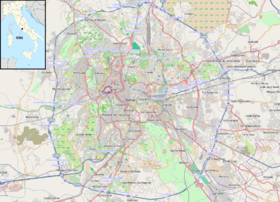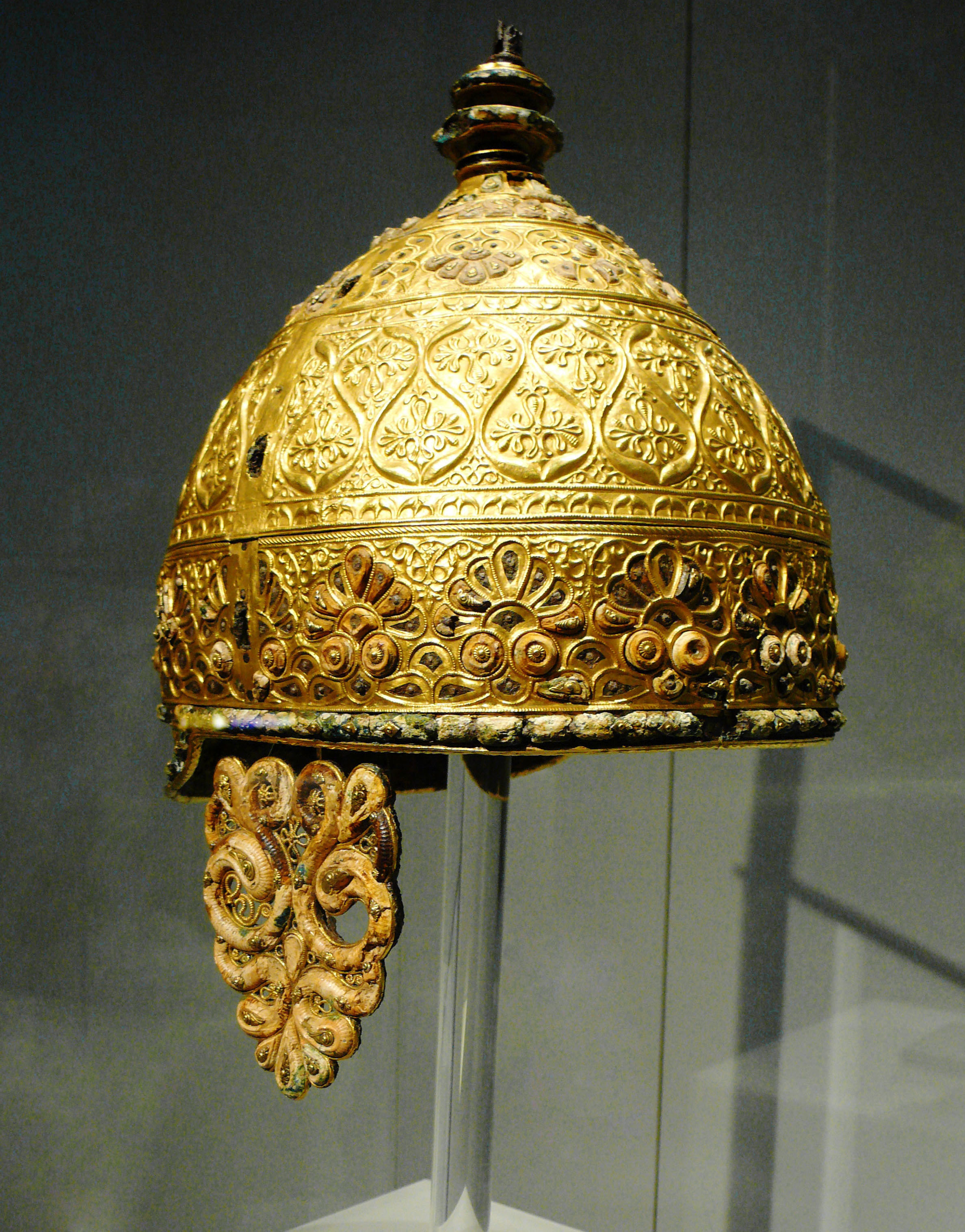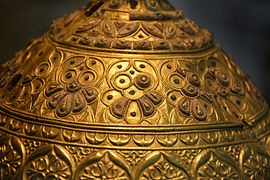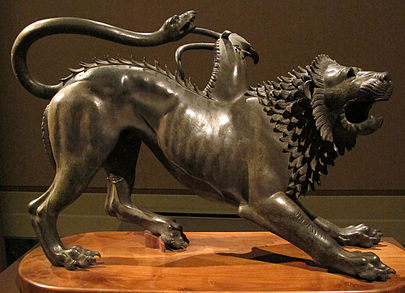Giacobbe Giusti, Le Camille, Musées du Capitole

Giacobbe Giusti, Le Camille, Musées du Capitole

| Ouverture |
1471
|
|---|---|
| Surface |
60 salles
|
| Visiteurs par an |
452 232 (2008)
|
| Site web |
| Collections |
sculptures, statues, mosaïques romaines, peintures
|
|---|
| Pays | |
|---|---|
| Commune |
Rome
|
| Adresse |
Piazza del Campidoglio, 1
|
| Coordonnées |
Géolocalisation sur la carte : Rome
- (Voir situation sur carte : Italie)
- (Voir situation sur carte : Latium)
Les musées du Capitole sont un ensemble de musées d’art et d’archéologie situés sur la Place du Capitole, à Rome. Fondés en 1471, ce sont les plus anciens musées du monde. Leurs collections comprennent des statues en marbre ou en bronze, des peintures, des mosaïques et des inscriptions, toutes en provenance de Rome et de sa région. Elles sont conservées dans les deux palais de la place du Capitole, le palais Neuf et le palais des Conservateurs, ainsi qu’à la centrale Montemartini, dans un faubourg de Rome.
Histoire
Giacobbe Giusti, Le Camille, Musées du Capitole

Le Camille, l’une des pièces fondatrices des collections Capitoline, bronze romain du ier siècle ap. J.-C.
Les musées du Capitole sont créés en 1471 par le pape Sixte IV pour accueillir quatre exceptionnelles statues de bronze, jusque-là conservés au palais du Latran et données au peuple romain : la Louve capitoline, le Camille, le Tireur d’épine et deux fragments d’une statue colossale de Domitien (la tête et une main tenant un globe). Comme le précise l’inscription conservée au palais des Conservateurs, il s’agit non d’une donation mais d’une « restitution » : « il jugea que ces remarquables statues de bronze, témoignage de la grandeur antique du peuple romain qui les avait créés, devaient lui être restituées et données sans réserve1. » Sixte IV choisit pour abriter les bronzes la colline du Capitoline, dominée alors par le vieux palais sénatorial, lui-même bâti sur les restes du tabularium, siège des archives romaines. La Louve est placée sur la façade du palais des Conservateurs, en remplacement du lion qui se trouvait là jusqu’alors, et devient le symbole de Rome.
En 1537, le pape Paul III ordonne le transfert au Capitole de la statue équestre en bronze de Marc Aurèle et demande à Michel-Ange de redessiner la place du Capitole pour l’accueillir. L’aménagement s’étalera sur un siècle : Michel-Ange remanie le palais sénatorial, qui donne sur le forum, mais la rénovation du palais des Conservateurs, à droite de la place, ne commence qu’en 1563. La première pierre du palais Neuf, jumeau de ce dernier, est posée en 1603. Le nouveau musée est inauguré en 1734, sous le pontificat de Clément XII.
Entretemps, les papes ont continué à enrichir les collections du musée. Ainsi, la statue en bronze doré d’Hercule, découverte sur le Forum Boarium, rejoint très vite le groupe original de bronzes. En 1513, c’est au tour de deux statues colossales de divinités fluviales. En 1566, Pie V donne un lot de trente statues en provenance du palais du Belvédère, jugeant inconvenant que le successeur de Pierre conserve chez lui des idoles païennes2. Dès 1523, les ambassadeurs vénitiens qualifient les collections capitolines des « plus belles et les plus célèbres au monde3 ».
Giacobbe Giusti, Musées du Capitole

Antinoüs capitolin, copie romaine d’une statue grecque du ive siècle av. J.-C.
L’enrichissement des collections marque le pas au xviie siècle, avant de reprendre de plus belle au xviiie siècle. En 1714, le pape Clément XI (1700-1721) fait don au musée de cinq statues égyptiennes trouvées aux environs de la Porte Salaria. En 1733, sous le pape Clément XII (1730-1740), le musée achète la collection du cardinal Alessandro Albani, comprenant des pièces majeures comme les Satyres della Valle, la Junon Cesi ou encore une statue d’Antinoüs découverte à la villa Adriana, mais aussi une série de portraits conservés aujourd’hui dans la salle des Empereurs et des Philosophes, qui suscitent beaucoup d’intérêt par leur valeur « documentaire ». L’abbé Barthélemy visitant le musée écrit ainsi au comte de Caylus :
« La première fois que j’entrai au musée du Capitole, je sentis le coup de l’électricité ; je ne saurais vous décrire l’impression que me firent tant de richesses assemblées. Ce n’est plus un cabinet ; c’est le séjour des dieux de l’ancienne Rome ; c’est le Lycée des philosophes ; c’est un Sénat composé des rois de l’Orient4. »
En 1734, le musée est ouvert au grand public. Le Galate mourantrejoint les collections la même année, le Faune du Capitole, en marbre rouge, en 1746 et la Vénus capitoline en 1750. Sous Clément XIII(1758–1769), le musée acquiert la mosaïque des Colombes et les deux centaures de marbre gris trouvés à la villa Adriana.
Benoît XIV (1740-1758) donne au complexe muséal une nouvelle orientation en créant la Pinacothèque capitoline, destinée à accueillir les collections des marquis Sacchetti et des princes Pio, rachetées par Silvio Valenti-Gonzaga, son cardinal secrétaire d’État. C’est le fruit d’une politique pontificale active, visant à empêcher les œuvres picturales de quitter Rome. Leur accueil nécessite la construction de deux salles ad hoc, la salle sainte Pétronille et la salle Pierre de Cortone.
La fin du xviiie siècle n’est pas favorable au musée : la fondation du musée Pio-Clementino, au Vatican, relance la compétition entre les collections communale et pontificale. Et en 1797, Napoléon Bonaparteimpose par le traité de Tolentino le transfert au musée du Louvre de certaines des pièces les plus fameuses — même si Antonio Canova à force d’obstination, ou plus probablement les clauses du Congrès de Vienne, feront revenir après la chute de Napoléon le Tireur d’épine, le Brutus capitolin, le Galate mourant et d’autres œuvres. Enfin, en 1838, la fondation du Musée grégorien égyptien par Grégoire XVI prive le musée de ses pièces égyptiennes.
Au xixe siècle, le musée accueille des pièces peu nombreuses, mais présentant un grand intérêt scientifique. Les collections sont réorganisées en 1903 par Rodolfo Lanciani selon des critères muséographiques plus rigoureux, mettant davantage en valeur le contexte archéologique des œuvres. Le musée est agrandi et accueille de nouvelles pièces, découvertes pendant les travaux urbains de l’époque Mussolinienne. On recrée la galerie qui reliait entre eux les palais Neuf et des Conservateurs, qui accueille une collection épigraphique. Une ancienne centrale électrique, baptisée du nom de son créateur, Martini, accueille une partie des collections, d’abord sur une base temporaire, puis de manière pérenne. Enfin, au début du xxie siècle, le projet « Grand Capitole » entraîne le réaménagement d’une grande partie du palais des Conservateurs.














































































